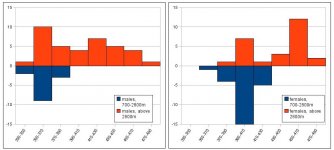There is further discussion of altitude and wing form here:
http://www.puce.edu.ec/zoologia/vertebrados/publicaciones/CabotDevries2006.pdf .
Other than that I have no intelligent comment. Here is a few links to the Literature cited by Clark et al:
http://elibrary.unm.edu/sora/Wilson/v076n02/p0121-p0137.pdf .
Additional observations on winter Bald Eagle populations: including remarks on biotelemetry techniques and immature plumages.
Aging Black-chested Buzzard-Eagle.
Abstract:
Most raptors have different age-related plumages that are usually replaced in annual molts. First
pennaceous plumage (juvenile) is called Basic I, 2nd plumage is Basic II, 3rd is Basic III, and so on. I studied wave molt in primaries, and replacement of tail and secondary feathers from museum specimens and pictures of wild hawks to determine the sequence and timing of immature plumages of Black-chested Buzzard-Eagles (Buteo melanoleucus). Juveniles (<1 year-old birds) have distinctive buff to tawny chests, pale and heavily-streaked heads, and upperwing coverts with noticeable buff to whitish tips (abraded after winter). One-year- to two-year-old birds are Basic II. They are overall dark with a brown vent that is barred black. A paler, short eyeline stands out on the darker head. Lesser upperwing coverts show tawny tips. Longer, new secondaries project beyond the trailing edge of wings in flying birds, and a few brown, juvenile tail feathers can be retained for the first year and a half of life. Basic III birds (roughly two-years- to three-years-old) have whitish bellies barred with black, gray upperwing coverts, and adult-like tail feathers. Some Basic II and most Basic III show black or slate breasts with a rufous median area. Basic III or younger birds show pale eyelines. Basic III or older show grey upperwing coverts. Basic IV birds look very much like adults but show some darker feathers in the belly and underwing coverts. Their chest and back are darker. Basic V birds are adult in plumage but a few tawny contour feathers might be retained.
The significance of molt centers among the secondary remiges in the Falconiformes.
http://elibrary.unm.edu/sora/Condor/files/issues/v043n02/p0113-p0115.pdf .
Molting sequence and aging of Bald Eagles.
http://elibrary.unm.edu/sora/Wilson/v101n01/p0001-p0010.pdf .
Molecular phylogenetics of the buteonine birds of prey (Accipitridae). Auk
http://research.calacademy.org/research/bmammals/Mindell/Lerner_et_al_2008_AUK.pdf .
Abstract
William S. Clark (Oral)
Wave Moult of the Primaries in Accipitrid Raptors and its Use in Ageing
Stresemann and Stresemann in 1966 described the wave moult for the Common Buzzard (Buteo buteo). However, this has since been largely ignored. Primaries of Accipitrid raptors are replaced from P1 (inner) sequentially outward. Waves are formed when not all ten primaries are replaced in any annual moult cycle, as the next moult begins anew at P1, as well as continuing with the next feather from where it left off in the last cycle. As many as three wave fronts of new primaries can be seen in some raptors, especially larger ones, e.g. eagles. Knowledge of wave moult can ascertain the ages of immature raptors in those species that take three or four years to attain adult plumage, since these species typically do not replace all the primaries in any one moult cycle. Juvenile eagles show all primaries the same age. Second plumage eagles show two ages of primaries, newer inner and older retained juvenile outer ones. Third plumage eagles show two waves, with the first wave proceeding to P8 to P10, and the second to P3 to P6. Fourth plumage eagles usually show new outer P10 from the first wave, new P5 to P7 from the second wave, and new P1 to P3 from the most recent wave. Fifth plumage eagles are essentially in adult plumage. I have verified wave moult in 39 species, mostly eagles, but also many buzzards.
2301 S. Whitehouse Circle, Harlingen, Texas 78550, USA
Tel: + 1-956-364-0415 • Email:
[email protected]
Primaries of Accipitrid raptors are replaced sequentially outward from the inner P1 to the outer P10, forming a wave. Many species in this family do not replace all ten primaries during the annual molt cycle. They begin the next molt cycle by continuing where the molt left off on the last cycle, AND, importantly, beginning a new wave of primary molt at P1. Knowledge of primary molt can be an important aid in ageing raptors that take more than one year to reach Definitive plumage, e.g., eagles, and in determining the first adult plumage of species that usually do not replace all primaries in the first molt, e.g., Red-tailed Hawk
(Buteo jamaicensis) and Rough-legged Hawk (B. lagopus). Juveniles always show all primaries the same age. Many first adult plumage buzzards show one to three retained juvenile outer primaries. Basic I eagles replace fewer primaries and show from three to six new inner primaries and the rest retained faded juvenile outer primaries. Basic II eagles show new inner primaries (from one to four), some new primaries farther out on the wing, beginning where the last wave of molt left off, in many cases, new P6 to P8. They usually show retained juvenile outer primary P10. Basic III eagles show three waves of new primaries: inner, midprimary, and outer new. I have noted wave molt in more than 75 species of Accipitrid raptors, including some as small as Broad-winged Hawk (Buteo platypterus) and Black-shouldered Kite (Elanus caerulus).
Molecular phylogeny of the genus Buteo (Aves: Accipitridae) based on mitochondrial marker sequences.
http://www.sciencedirect.com/scienc...serid=10&md5=77e033b36f54bceef1704154f48dc38e .





